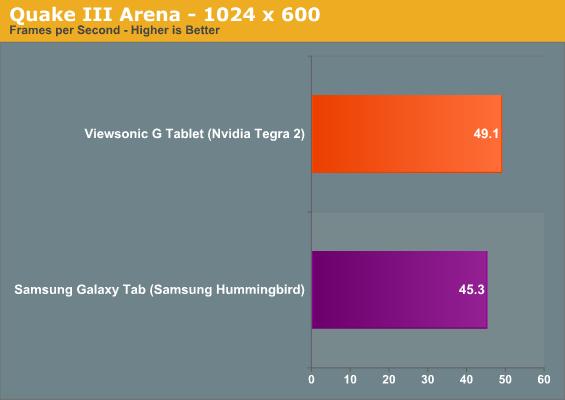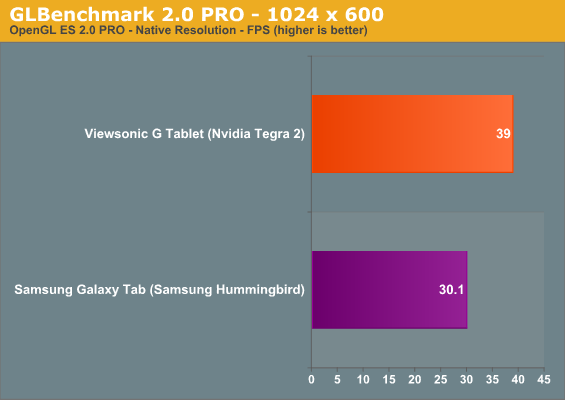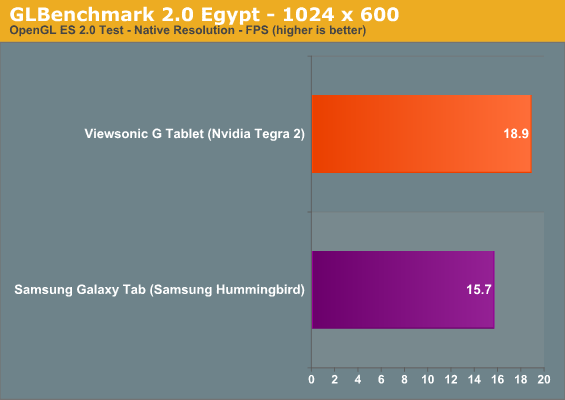Nvidia Tegra 2 - Graphics Performance Update
by Vivek Gowri on December 20, 2010 11:00 PM EST

So I have a confession to make. Before we posted our Tegra 2 performance preview, I ran the Quake 3 demo on the Viewsonic G Tablet and the Samsung Galaxy Tab three times each. I ended up with 49.0, 48.2 and 49.9 fps on the Viewsonic, and 31.9, 32.2, and 32.1 fps on the Galaxy Tab. Run the averages, and you get 49.1 fps for the Viewsonic and 32.1 fps for the Galaxy. Based on some input from Imagination and other Galaxy Tab users, we decided to retest the Galaxy Tab, since our results were a good bit lower than what they were reporting.
And on re-running the Quake 3 benchmark, I got results in the 44.9 - 46.0 range. I ran it over 50 times trying to replicate the previous scores, but under no conditions (settings, background applications, etc) could I get anywhere near my previous result. I know for a fact that the settings were all correct and that there were no previously running applications, so I really have no idea why I got a framerate that low, much less why it was repeatable.
In addition to retesting Quake 3 on the Galaxy Tab, I also ran both slates through GLBenchmark 2.0, which we recently added to our benchmark suite. The combination of the two gave me enough reason to write up an update to our Tegra 2 performance preview from two weeks ago. I was also planning to compare Quadrant’s 3D graphics score, but I was unable to get the SlideME store working on the Viewsonic to download Quadrant Professional.
So, let’s get to it. With the revised Quake 3 benchmarks, Tegra 2 has a slight 10% lead over the SGX 540, bringing it more in line with what we expected. Looking at our GLBenchmark 2.0 results, we can see that Tegra 2 has the lead here as well, though by a slightly larger margin. In GLBenchmark Pro, the Tegra 2 has a 30% lead over the Hummingbird, while in the more-demanding Egypt benchmark, the gap shrinks to 20.4%.



So while the performance difference isn’t nearly as dramatic as we originally thought, most of what we said before still holds true. It looks like Tegra 2 has the potential to be the best SoC for Android gaming, making it a really attractive platform for tablets. With all the rumours flying around about Google making Tegra 2 the reference platform for Honeycomb-based tablets, apparently we’re not the only ones who think so. The question is how well will it handle existing 3D content that's likely optimized for Qualcomm and Imagination Technologies GPUs.
We’ll take a more in-depth look at Tegra 2’s performance as well as power consumption in our full review later this month, and hopefully by that time we can give you the Quadrant benchmarks as well. But for now, we can say that Tegra 2 is the most powerful SoC on the market at present and makes for a very capable tablet platform.










27 Comments
View All Comments
ArchAngel777 - Tuesday, December 21, 2010 - link
It will be real interesting to see if this performance increase comes at the cost of battery life.knedle - Tuesday, December 21, 2010 - link
On my G1 8 hrs of listening to music = ~32 hrs battery life, while no listening to music = ~72 hrs of battery life.So it looks like playing games or running 3D eye candy could ruin your battery even faster.
vol7ron - Tuesday, December 21, 2010 - link
I don't understand your assessment. 8hrs music = 32 hrs battery? Does that mean with listening to your music you had ~24hrs of standby or ~32 afterwards? Did you talk on the phone, was it hooked up to wifi (any dead zones)? Did you use the internet?I know you're trying to give an estimate, but I'm not clear on your figures or any of the background behind it.
"So it looks like playing games or running 3D eye candy could ruin your battery even faster"
I don't think the question was if it would use more power to play the games, I think he wanted to know if the same games would require more/less juice w/ the new hardware. - I'm curious if just the standby graphics would require more/less energy.
Just because it can do more things, does not necessarily make it less efficient.
amitp - Tuesday, December 21, 2010 - link
Okey, I'm no H/W expert, So please don't kill me if I'm wrong.As per my knowledge Tegra 2 is dual core SoC and samsung hummingbird is Single Core SoC and only a little performance gain over samsung hummmingbird ?
I also read somewhere that Samsung will use Tegra 2 in future for its devices. If they can make dual core hummingbird SoC, then I think they will get better performance then Tegra 2 ?
Regards
amitp
aegisofrime - Tuesday, December 21, 2010 - link
Vivek Gowri, perhaps the Galaxy was unplugged when you tested it the first time?@amitp, Samsung indeed does have a dual-core SoC. It's called Orion, although some news sites are reporting that Samsung bought a whole bunch of Tegra 2 chips. Either they are giving up on Orion, or they are just using Tegra to tide them over until Orion is ready. Hummingbird is supposed to be a beast of a chip though, so Samsung indeed has the capability to design a very good SoC.
leomax999 - Tuesday, December 21, 2010 - link
Samsung mobile division follows different strategy. They dont always go with in-house components.Looks like Orion would better Tegra 2,but would take some more time to market,crucially.
Goffers - Tuesday, December 21, 2010 - link
Remember that Samsung are using a Qualcomm Snapdragon for their first Windows Phone 7's - as required by MSFT. Presumably Sg are not too proud to use a foreign SOC as a stopgap.Alexvrb - Tuesday, December 21, 2010 - link
Well that is certainly smart of them, for multiple reasons. For one, they don't risk being late to market because they are waiting on a new chip, or worse, being forced to launch with a previous gen chip because their new chip wasn't ready yet. Also, they are drawing from multiple sources so they don't have to worry quite as much about demand outstripping their own in-house chip production. They don't have all their eggs in one basket, in other words.Another side benefit is that it pushes Samsung's chip designers to put out a competitive product.
TareX - Wednesday, December 22, 2010 - link
Orion is not power friendly at all. It's GPU was super-duper-uber powerful, but not battery friendly -unlike, of course, Tegra 2 SOC.blueboy_10 - Thursday, December 23, 2010 - link
Hey, I thought I heard somewhere that the Tegra 2 chips were to improve on battery life quite a bit. Has anybody heard on this? I'm just curious, cause that would do good on a smartphone with capabilities. Just think: a smartphone that like your computer/laptop, a good camcorder (1080p of course), and a very good camera, with this time some superior UI on it, all the while taking minimum bit on your battery life. Sound like 2012/2013 or out of our reach for sure, who knows? -BLUEBOY